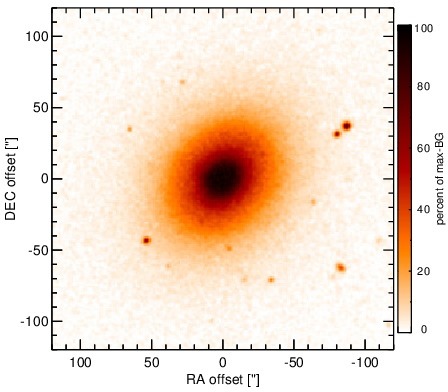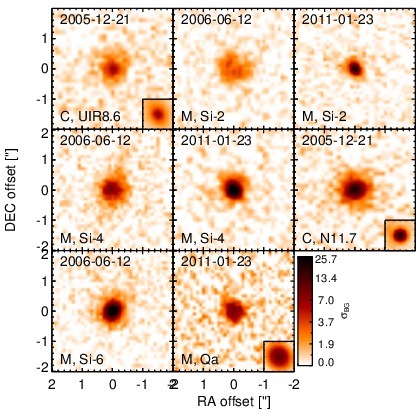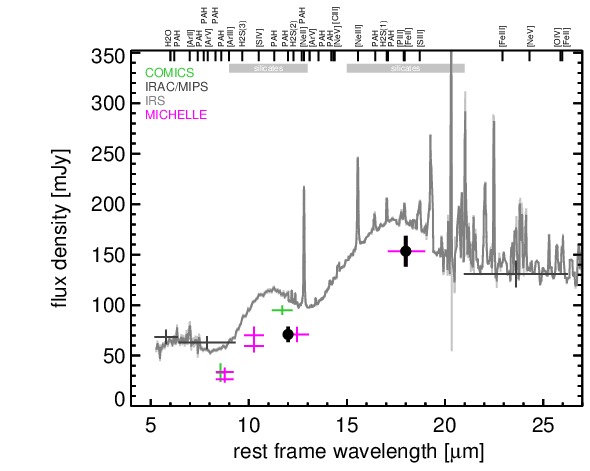Sasmirala Individual Information for NGC 3998
Description
NGC 3998 is an early-type spiral galaxy at a distance of D = 14.1 ± 1.3 Mpc [tonry_sbf_2001] with a variable radio-loud broad-line LINER nucleus [veron-cetty_catalogue_2010]. It features a compact flat-spectrum radio core with a jet-like northern extension (e.g., [filho_light-year_2002]), and a disc-like NLR with a major axis of ~ 3arcsec ~ 200 pc and a PA~ 90∘ [pogge_narrow-line_2000]. The first ground-based MIR observations of NGC 3998 were carried out with IRTF and UKIRT in 1983 and 1984 [sparks_infrared_1986, willner_infrared_1985]. In addition, it was observed with ISO [knapp_iso_1996] and Spitzer/IRAC, IRS and MIPS. The corresponding images show a dominating nucleus embedded within elliptical emission. The LR IRS spectrum exhibits strong silicate 10 and 18 μm emission features and a shallow blue spectral slope in νFν-space but no PAH features (see also [sturm_silicate_2005, mason_nuclear_2012]). The nuclear region of NGC 3998 was observed with COMICS in two N-band filters in 2005 (unpublished, to our knowledge), and with Michelle in three N and one Q-band filters in 2006 and 2011 [mason_nuclear_2012]. A compact nucleus without host emission was detected in all images but the shape and extent of the source is inconsistent in the different images. Therefore, we classify its subarcsecond MIR extension as uncertain . Our nuclear photometry provides values generally consistent with [mason_nuclear_2012], except for the Qa flux, which is stated ~ 25% lower in the latter work. In addition, the subarcsecond photometry is on average ~ 36% lower than the Spitzer spectrophotometry. The strength of the silicate 10 μm emission seems to be comparable though, which indicates that it is caused in the projected central ~ 25 pc of NGC 3998. Therefore, we use only the Si-6 flux for the 12 μm continuum emission estimate.
- [filho_light-year_2002] M. E. Filho, P. D. Barthel, and L. C. Ho. Light-year scale radio cores in four LINER galaxies . A&A , 385 pp. 425–430, April 2002.
- [knapp_iso_1996] G. R. Knapp, M. P. Rupen, M. Fich, D. A. Harper, and C. G. Wynn-Williams. ISO observations of hot dust in the nucleus of the s0 galaxy NGC 3998. . A&A , 315 pp. L75–L78, November 1996.
- [mason_nuclear_2012] R. E. Mason, E. Lopez-Rodriguez, C. Packham, A. Alonso-Herrero, N. A. Levenson, J. Radomski, C. Ramos Almeida, L. Colina, M. Elitzur, I. Aretxaga, P. F. Roche, and N. Oi. The nuclear infrared emission of low-luminosity active galactic nuclei. AJ , 144 pp. 11, July 2012.
- [pogge_narrow-line_2000] Richard W. Pogge, Dan Maoz, Luis C. Ho, and Michael Eracleous. The narrow-line regions of LINERS as resolved with the hubble space telescope . ApJ , 532 pp. 323–339, March 2000.
- [sparks_infrared_1986] W. B. Sparks, J. H. Hough, D. J. Axon, and J. Bailey. Infrared photometry of the nuclei of early-type radio galaxies . MNRAS , 218 pp. 429–444, February 1986.
- [sturm_silicate_2005] E. Sturm, M. Schweitzer, D. Lutz, A. Contursi, R. Genzel, M. D. Lehnert, L. J. Tacconi, S. Veilleux, D. S. Rupke, D.-C. Kim, A. Sternberg, D. Maoz, S. Lord, J. Mazzarella, and D. B. Sanders. Silicate emissions in active galaxies: From LINERs to QSOs . ApJL , 629 pp. L21–L23, August 2005.
- [tonry_sbf_2001] John L. Tonry, Alan Dressler, John P. Blakeslee, Edward A. Ajhar, André B. Fletcher, Gerard A. Luppino, Mark R. Metzger, and Christopher B. Moore. The SBF survey of galaxy distances. IV. SBF magnitudes, colors, and distances . ApJ , 546 pp. 681–693, January 2001.
- [veron-cetty_catalogue_2010] M.-P. Véron-Cetty and P. Véron. A catalogue of quasars and active nuclei: 13th edition . A&A , 518 pp. 10, July 2010.
- [willner_infrared_1985] S. P. Willner, M. Elvis, G. Fabbiano, A. Lawrence, and M. J. Ward. Infrared observations of LINER galactic nuclei . ApJ , 299 pp. 443–461, December 1985.
Images

Optical image (DSS, red filter). Displayed are the central 4 arcmin with North being up and East to the left. The colour scaling is linear with white corresponding to the median background (BG) and black to the 0.01% pixels with the highest intensity.

Spitzer MIR images. Displayed are the inner 40 arcsec with North being up and East to the left. The colour scaling is logarithmic with white corresponding to median BG and black to the 0.1% pixels with the highest intensity. The label in the bottom left states instrument and central wavelength of the filter in micron (I: IRAC, M: MIPS).

Subarcsecond-resolution MIR images sorted by increasing filter central wavelength. Displayed are the inner 4 arcsec with North being up and East to the left. The colour scaling is logarithmic with white corresponding to median BG and black to the 75% of the highest intensity of all images in units of sig_bg. The inset image (where present; either bottom or top right) shows the central arcsecond of the PSF from the calibrator star, scaled to match the science target. The labels in the bottom left state instrument and filter names (C: COMICS, M: Michelle, T: T-ReCS, V: VISIR).
SEDs


MIR SED. The description of the symbols in all the SED plots (where present) is the following: Grey crosses and solid lines mark the Spitzer/IRAC, MIPS and IRS data. The colour coding of the other symbols is as follows: green for COMICS, magenta for Michelle, blue for T-ReCS and red for VISIR data. Darker-coloured solid lines mark spectra of the corresponding instrument. The black filled circles mark the nuclear 12 and 18 micron continuum emission estimate from the data (where present). The ticks on the top axis mark positions of common MIR emission lines, while the light grey horizontal bars mark wavelength ranges affected by the silicate 10 and 18 micron features.